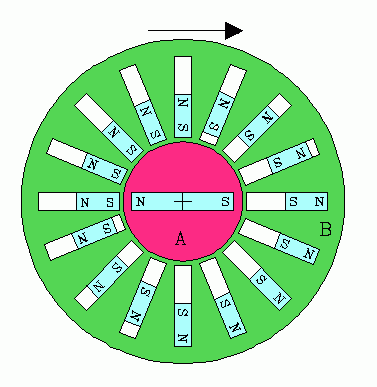The Simplest Magnetic Motor.
 This simple design has many interesting things going on simultaneously.
Of course, Stevin's principle tells is it can't increase its speed. But
it's fun to look at the details.
This simple design has many interesting things going on simultaneously.
Of course, Stevin's principle tells is it can't increase its speed. But
it's fun to look at the details.The magnets move, but repeat that motion exactly every cycle. So their gravitational potential energy change is zero during each cycle. Their magnetic potential energy change with respect to the fixed magnet is also zero during each cycle.
Clearly at any instant there's more net gravitational torque on the right side because the magnets there are farther from the axle. But as with all "overbalanced wheels" this also increases the moment of inertia of those magnets, so this does not cause acceleration of the wheel's rotation.
The wheel is always a bit bottom-heavy. So what? That certainly doesn't help the wheel to turn. But it's not an important issue.
At any instant, the magnets on the bottom half are farther from the axle than those on the upper half (due to gravity). Being farther from the magnet in the axle, the bottom magnets experience smaller magnetic force.
Let's get to the really interesting thing that magnetic motion machine inventors invariably overlook and do not include in their calculations (if they bother to calculate at all). The outer magnets experience a torque from the magnetic attraction and repulsion of the axle magnet's poles. This torque is communicated to the wheel by reaction forces at the walls of the each magnet's chamber.
Look at the topmost magnet. Its S pole experiences a repulsion from the S pole of the axle magnet, and an attraction to the N pole of the axle magnet. This gives a net force on this magnet that has a horizontal leftward component. By similar argument we see that this top magnet's N pole has a horizontal component to the right, which is somewhat smaller. These cause a clockwise torque on this upper magnet.
The lowermost magnet experiences a counterclockwise torque, by similar argument. One can do the same sort of analysis on all of the other magnets, but you get the idea.
Now the torque on the upper magnet is greater than that on the lowest magnet, because it is closer to the axle. But the torque these magnets exert about the axis of the wheel is what's important. I.e., we must take the magnet's lever arm, the distance from the magnet to the axle, into account. It's a complicated problem to work out, but the net result is that the net torque of all the magnets on the wheel is zero. Curses, foiled again!
In the real world we'd have friction in the chamber walls, at the axle, and dissipative processes within the magnets removing energy irreversibly. Even if all these dissipative processes were absent, the wheel would perform no better than a simple flywheel. It might be fascinating to watch if the wheel were driven by a hidden power source.
 |
| Earlier version of this idea. |
|---|
Not quite so simple version.
The design above evolved from the one shown here. Magnets slide in frictionless channels, those on opposite sides of the axle are connected by rigid rods. A large fixed magnet ouside the wheel has its N and S poles as shown. The N pole attracts the S poles of the sliding magnets, as they pass from A to B, pulling them out to a larger radius. The external S pole at the lower left helps this process. The net result is to unbalance the wheel continually, the sliding magnets always having greater lever arms on the right. So gravity causes the wheel to turn continuously.If you are new to this game, try to relate this to other perpetual motion wheel designs that attempt to achieve constant motion by continuous imbalance, until you can "see" the fundamental futility of the idea.
Return to the Annex.